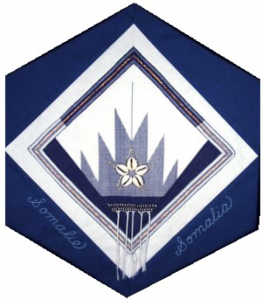Somalia

The Block
Traditional clothing, which consists of brightly coloured cloth draped toga-style over the body, is still the norm in much of Somalia. For this block a piece of a Alindi cloth, typically woven by teenage boys in the Mogadishu markets and used as a woman’s head-covering, was chosen by Faduma Abdurahman as the central feature. The cloth was creatively cut and folded to produce the geometric design featured.
Gold threads, woven throughout the material made national colours, indicate pride and prosperity, and as such are worn only by women of the village. Men, forbidden to wear gold, often wear intricately adorned daggers. In the centre, a gold-work star is filled with five cowrie shells, which are traditionally used to decorate items such as the animal skin bags used to carry water. A hand-woven black and white braid, typical of the fringe trimming head coverings, embellishes the piece. The number of shells, points of the star, and hanging threads symbolize the five regions (Eritrea, Djibouti, Kenya, Ethiopia and Somalia) into which Somali people were historically divided by colonial powers.
Cultural Profile
The Republic of Somalia, which is geographically shaped like the number seven, lies on the Horn of Africa in the easternmost part of the continent. It is an arid nation that has no lakes or permanent water, except for the Juba and Shebelle Rivers, which are used to irrigate crops. Somalia was previously known as Italian Somaliland and British Somaliland and is now one of the few countries to grow myrrh and frankincense trees, the gum of which has been traded for thousands of years. Northern Somalia is the world’s largest producer of frankincense and the only manufacturer of Maydi frankincense gum. The country’s official language is Somali, although Arabic, Italian and English are also spoken.
Somalia is one of the most ethnically and culturally homogenous nations in Africa, although there are divisions according to traditional clan groupings. Most of the population belongs to one of four clans, known together as the Samaal, who are primarily nomadic herders. Members of two additional clans, known as the Sab or Saab, live along the rivers and farm the land. All are a proud people to whom saving face is very important, and all share a deep belief in individual freedom and equality.
Somalis are famous for their eloquence, their wit, and their stories. They have a long tradition of art and music, where percussion and the oud are the two major instruments. It is however the art of oral poetry and song for which they are best known. Poetic competitions, often accompanied by the chewing of qat (a mild stimulant) involve the recitation of centuries-old poems, and are a vital part of Somali life.
National crafts include woven mats, wood and stone carvings, leather goods such as handbags and dagger sheaths, and fine silver jewellery. Women wear the colourful guntino, a long wrap-around dress of alandi cotton made locally by weavers, while the men wear the macawis, a sarong-like wrap around skirt.
Somalis have been coming to Canada since the 1940s, settling in Ontario, Québec, the Maritime Provinces, Manitoba and Saskatchewan. Many come as refugees fleeing the turmoil of their homeland, while others come for economic reasons. Canada has one of the largest Somali population outside of the Horn of Africa, numbering 45,000. Notable Somali Canadians include the best-selling rap artist K’naan.
Sponsor: Susan & Malcolm Robertson
